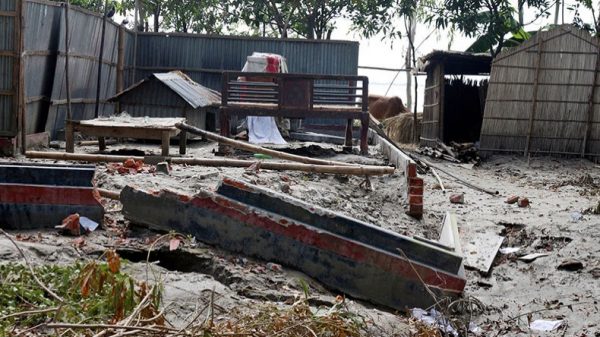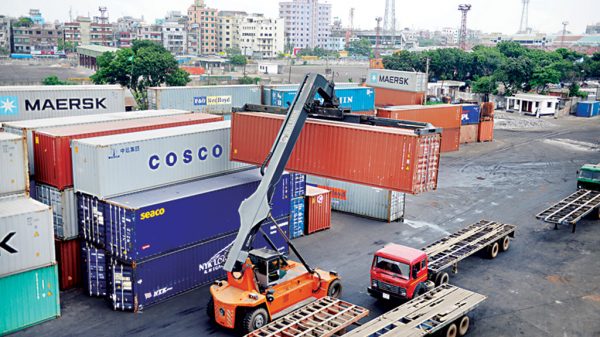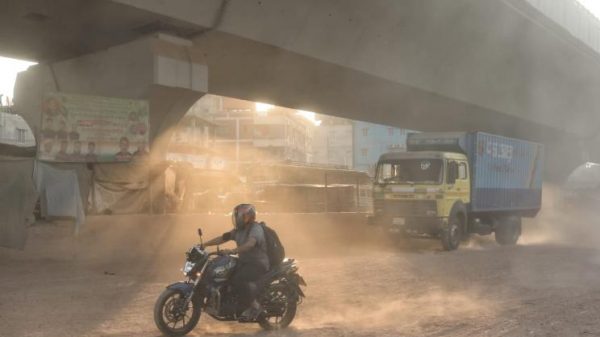Vast area in ruins as flood waters recede

Shawdesh Desk:
A vast area of rural Bangladesh affected by the two consecutive spells of flood lies in ruins with its road network severely damaged and villages sunk in thick layers of silt as flood waters are receding after wreaking havoc for up to three weeks at places.
Thousands of marooned villagers, after spending days under the open sky on embankments or in government shelters, struggled to return home wading through several feet of mud lying on their way.
Back at home, many of them found wooden and bamboo pillars of their houses rotting from being submerged in flood waters for days and parts of their houses washed away.
Some of them returned to find their houses retaining only their roofs made of CI sheets.
‘A protracted hard time lies ahead of people as they seek to rebuild literally from the scratch,’ Matiur Rahman, chairman, Nageshwari union parishad, told the New Age correspondent in Kurigram.
Matiur said that earthen country roads were dotted with big holes holding gallons of waters making it difficult for people even to walk.
Gorostan para in Kurigram Sadar upazila is covered in mud with its inhabitants waiting for sunny days to dry it up so that they can resume their normal activities.
‘You need to see this to believe it,’ said Abdul Baten, chairman, Shaheber Alga union parishad, Ulipur, Kurigram, referring to the condition left by the floods.
Kurigram press club general secretary Aminur Rahman said that at least 80 per cent earthen roads in the district’s rural areas were rendered unusable by the two spells of flood since July 10.
Aminur said that a steady flow of water from the upstream across the border caused more damages than feared in the northern district.
He said that more water inundated Bangladesh during the 1988 flood but that happened rapidly and the water flowed downstream within a short span of time.
The 1998 flood, however, stayed for a long time as rivers carried water downstream slowly but the water flow from the upstream was not as persistent as observed this year, he said.
Staying without work for long due to the prolonged flood left most of the affected poor without a penny to cope with the massive reconstruction works now they are faced with, he said.
He was afraid that the damaged earthen country roads might not be repaired by the government again leaving poor villagers in constant hardships for the days to come.
The New Age correspondent in Lalmonirhat said that affected people sought government assistance in helping them rebuild their damaged homes.
People of 63 chars in the northern districts are among the worst sufferers for they hardly received any relief during the floods and are now faced with the mammoth task of rebuilding apparently on their own.
Lalmonirhat deputy commissioner Abu Jafor, however, said that they were preparing a list of flood-affected people for a post-flood rehabilitation programme that is to begin soon.
The disaster management and relief ministry said that except for some places in seven northern and central districts flood waters receded from rest of the 21 affected districts by Thursday.
More than 27,000 people are still living on embankments and temporary flood shelters in the seven districts – Bogura, Gaibandha, Faridpur, Jamalpur and Tangail, according to the ministry.
The ministry estimated that the floods marooned 60,74,415 villagers in 6,053 villages in the affected 28 districts. Of them, 6,30,383 villagers lost everything.
The floods damaged 33,735 houses completely and 532,643 houses partially, forcing 1,74,650 people to seek refuge in 1,639 government shelters, the ministry said in its primary estimates published on July 27.
Floods also killed 45 cattle heads, 22,339 farm birds, damaged 4,939 educational and religious institutions, 7,027 kms of roads, 458 kms of embankments and 297 bridges and culverts, according to the estimates.
The estimates, however, did not take into account the earthen rural roads.
Triggered by heavy rains in the upstream and inside Bangladesh, the floods killed 108 people since July 10, according to the Health Emergency Operation Centre and Control Room.
The Flood Forecasting and Warning Centre on Thursday predicted that major rivers in the country might continue to recede until Saturday morning.
Only the Kushiyara and Titas rivers were flowing above their danger levels at Sherpur in Sylhet and at Brahmanbaria respectively at 9:00am on Thursday, said the FFWC.
The FFWC recorded the country’s highest rainfall of 171 mm in 24 hours till Thursday morning at Moheshkhola.
It rained 81 mm during the same period in India’s Gowahati, said the FFWC.
The Indian Met Office predicted widespread to fairly widespread rainfall in Assam and Meghalaya and West Bengal and Sikkim until Monday.
The FFWC predicted that another spell of flood might hit Bangladesh in the latter part of August.
The Bangladesh Met Office predicted rains at many places in Dhaka, Barishal, Chattogram and Khulna divisions and at a few places over the rest of the divisions.























Leave a Reply